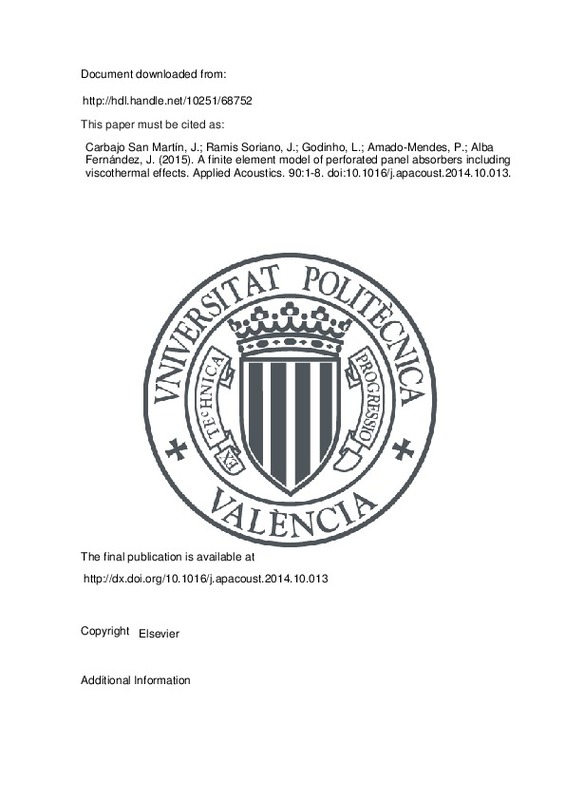JavaScript is disabled for your browser. Some features of this site may not work without it.
Buscar en RiuNet
Listar
Mi cuenta
Estadísticas
Ayuda RiuNet
Admin. UPV
A finite element model of perforated panel absorbers including viscothermal effects
Mostrar el registro sencillo del ítem
Ficheros en el ítem
| dc.contributor.author | Carbajo San Martín, Jesús
|
es_ES |
| dc.contributor.author | Ramis Soriano, Jaime
|
es_ES |
| dc.contributor.author | Godinho, Luis
|
es_ES |
| dc.contributor.author | Amado-Mendes, Paulo
|
es_ES |
| dc.contributor.author | Alba Fernández, Jesús
|
es_ES |
| dc.date.accessioned | 2016-09-05T14:15:36Z | |
| dc.date.available | 2016-09-05T14:15:36Z | |
| dc.date.issued | 2015-04-01 | |
| dc.identifier.issn | 0003-682X | |
| dc.identifier.uri | http://hdl.handle.net/10251/68752 | |
| dc.description.abstract | Most of the analytical models devoted to determine the acoustic properties of a rigid perforated panel consider the acoustic impedance of a single hole and then use the porosity to determine the impedance for the whole panel. However, in the case of not homogeneous hole distribution or more complex configurations this approach is no longer valid. This work explores some of these limitations and proposes a finite element methodology that implements the linearized Navier Stokes equations in the frequency domain to analyse the acoustic performance under normal incidence of perforated panel absorbers. Some preliminary results for a homogenous perforated panel show that the sound absorption coefficient derived from the Maa analytical model does not match those from the simulations. These differences are mainly attributed to the finite geometry effect and to the spatial distribution of the perforations for the numerical case. In order to confirm these statements, the acoustic field in the vicinities of the perforations is analysed for a more complex configuration of perforated panel. Additionally, experimental studies are carried out in an impedance tube for the same configuration and then compared to previous methods. The proposed methodology is shown to be in better agreement with the laboratorial measurements than the analytical approach. (C) 2014 Elsevier Ltd. All rights reserved. | es_ES |
| dc.language | Inglés | es_ES |
| dc.publisher | Elsevier | es_ES |
| dc.relation.ispartof | Applied Acoustics | es_ES |
| dc.rights | Reserva de todos los derechos | es_ES |
| dc.subject | Perforated panels | es_ES |
| dc.subject | Sound absorption | es_ES |
| dc.subject | Navier-Stokes equations | es_ES |
| dc.subject | FEM | es_ES |
| dc.subject.classification | FISICA APLICADA | es_ES |
| dc.title | A finite element model of perforated panel absorbers including viscothermal effects | es_ES |
| dc.type | Artículo | es_ES |
| dc.identifier.doi | 10.1016/j.apacoust.2014.10.013 | |
| dc.rights.accessRights | Abierto | es_ES |
| dc.contributor.affiliation | Universitat Politècnica de València. Escuela Politécnica Superior de Gandia - Escola Politècnica Superior de Gandia | es_ES |
| dc.contributor.affiliation | Universitat Politècnica de València. Departamento de Física Aplicada - Departament de Física Aplicada | es_ES |
| dc.contributor.affiliation | Universitat Politècnica de València. Centro de Tecnologías Físicas: Acústica, Materiales y Astrofísica - Centre de Tecnologies Físiques: Acústica, Materials i Astrofísica | es_ES |
| dc.description.bibliographicCitation | Carbajo San Martín, J.; Ramis Soriano, J.; Godinho, L.; Amado-Mendes, P.; Alba Fernández, J. (2015). A finite element model of perforated panel absorbers including viscothermal effects. Applied Acoustics. 90:1-8. doi:10.1016/j.apacoust.2014.10.013 | es_ES |
| dc.description.accrualMethod | S | es_ES |
| dc.relation.publisherversion | http://dx.doi.org/10.1016/j.apacoust.2014.10.013 | es_ES |
| dc.description.upvformatpinicio | 1 | es_ES |
| dc.description.upvformatpfin | 8 | es_ES |
| dc.type.version | info:eu-repo/semantics/publishedVersion | es_ES |
| dc.description.volume | 90 | es_ES |
| dc.relation.senia | 298356 | es_ES |
| dc.identifier.eissn | 1872-910X |







![[Cerrado]](/themes/UPV/images/candado.png)

